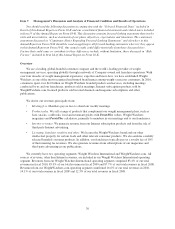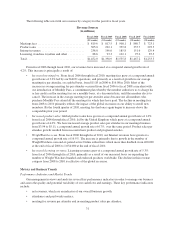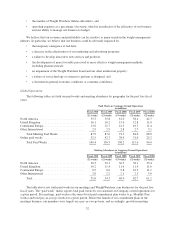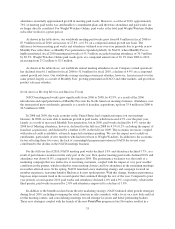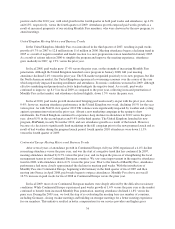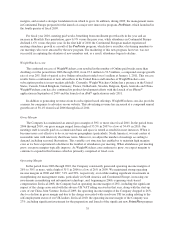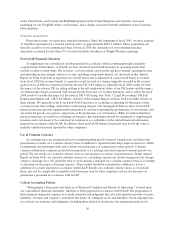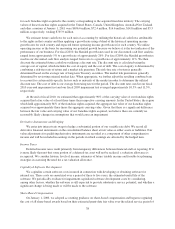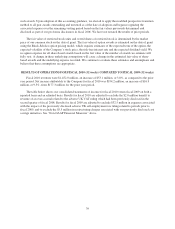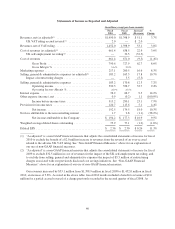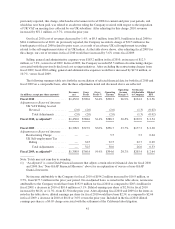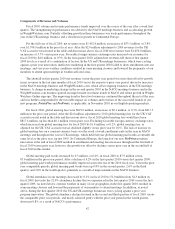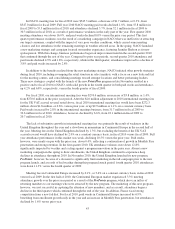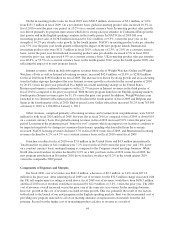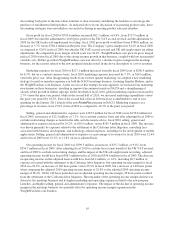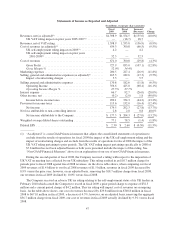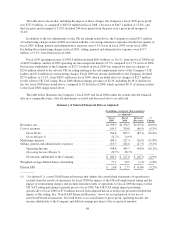WeightWatchers 2010 Annual Report Download - page 54
Download and view the complete annual report
Please find page 54 of the 2010 WeightWatchers annual report below. You can navigate through the pages in the report by either clicking on the pages listed below, or by using the keyword search tool below to find specific information within the annual report.f
or each franchise right acquired is the country corresponding to the acquired franchise territory. The carrying
values of these franchise rights acquired in the United States, Canada, United Kingdom, Australia/New Zealan
d
and other countries at January 1, 2011 were
$
656.6 million,
$
72.4 million,
$
16.6 million,
$
14.8 million and
$
5.5
million, respectively, totaling
$
765.9 million.
We estimate future cash flows for each unit of accounting by utilizing the historical cash flows attributable
to the rights in that country and then applying a growth rate using a blend of the historical operating income
growth rates for such country and expected future operating income growth rates for such country. We utilize
o
perating income as the basis for measuring our potential growth because we believe it is the best indicator of the
p
erformance of our business. For fiscal 2010, the blended growth rates used in our discounted cash flow analysis
r
anged from approximately
5
% to a growth rate of approximately 26%. For fiscal 2009, the blended growth rates
used in our discounted cash flow analysis ranged from zero to a growth rate of approximately 11%. We the
n
discount the estimated future cash flows utilizing a discount rate. The discount rate is calculated using th
e
average cost of capital, which includes the cost of equity and the cost of debt. The cost of equity is determined b
y
combining a risk-free rate of return and a market risk premium. The risk-free rate of return is generally
determined based on the average rate of long-term Treasury securities. The market risk premium is generally
determined by reviewing external market data. When appropriate, we further adjust the resulting combined rate
to account for certain entity-specific factors such as maturity of the market in order to determine the utilize
d
discount rate. The cost of debt is our average borrowing rate for the period. The discount rates used in our fisca
l
2010 year-end impairment test and our fiscal 2009 impairment test averaged approximately 10.
5
% and 11.
5
%
,
r
espectively.
A
t the end of fiscal 2010, we estimated that approximately 90% of the carrying value of our franchise right
s
acquired had a fair value of at least three times their respective carrying amounts. In the United States, the regio
n
which held approximately 86% of the franchise rights acquired, the aggregate fair value of our franchise right
s
acquired was approximately three times the aggregate carrying value. Given that there is a significant difference
between the fair value and carrying value of our franchise rights acquired, we believe there are currently n
o
r
easonably likely changes in assumptions that would cause an impairment.
Derivative Instruments and Hedgin
g
We enter into interest rate swaps to hedge a substantial portion of our variable rate debt. We record al
l
derivative financial instruments on the consolidated balance sheet at fair value as either assets or liabilities. Fai
r
value adjustments for qualifying derivative instruments are recorded as a component of other comprehensive
income and will be included in earnings in the periods in which earnings are affected by the hedged item.
Income Taxe
s
Deferred income taxes result primarily from temporary differences between financial and tax reporting. If it
is more likely than not that some portion of a deferred tax asset will not be realized, a valuation allowance is
r
ecognized. We consider historic levels of income, estimates of future taxable income and feasible tax planning
strategies in assessing the need for a tax valuation allowance
.
Capitalized So
f
tware Developmen
t
We capitalize certain software costs incurred in connection with developing or obtaining software for
internal use. These costs are amortized over a period of three to five years, the estimated useful life of th
e
software. We periodically evaluate for impairment capitalized software development costs by considering,
among other factors, whether the software is still expected to provide substantive service potential, and whether a
significant change is being made or will be made to the software.
S
hare-Based Com
p
ensatio
n
On January 1, 2006, we adopted accounting guidance on share-based compensation and began recognizin
g
the cost of all share-based awards based on their estimated grant-date fair value over the related service period of
38




